Artificial Intelligence's Impact on HR: A Comprehensive Analysis
VerifiedAdded on 2022/08/12
|10
|2861
|29
Essay
AI Summary
This essay delves into the transformative impact of Artificial Intelligence (AI) on Human Resources (HR) functions. It explores how AI technologies, including machine learning, are enhancing HR operations by automating tasks, improving employee performance, and reducing costs. The discussion covers key areas such as recruitment, employee efficiency, personnel growth, and employee wellbeing, highlighting how AI-driven tools are used to streamline processes and make data-driven decisions. The essay emphasizes the benefits of AI in eliminating biases, improving response times, and providing valuable insights for HR professionals. The conclusion highlights that AI will align with the entire HR operations especially recruitment process to make structural changes essential for implementation and allowing significantly improved employment outcomes, poorer day.
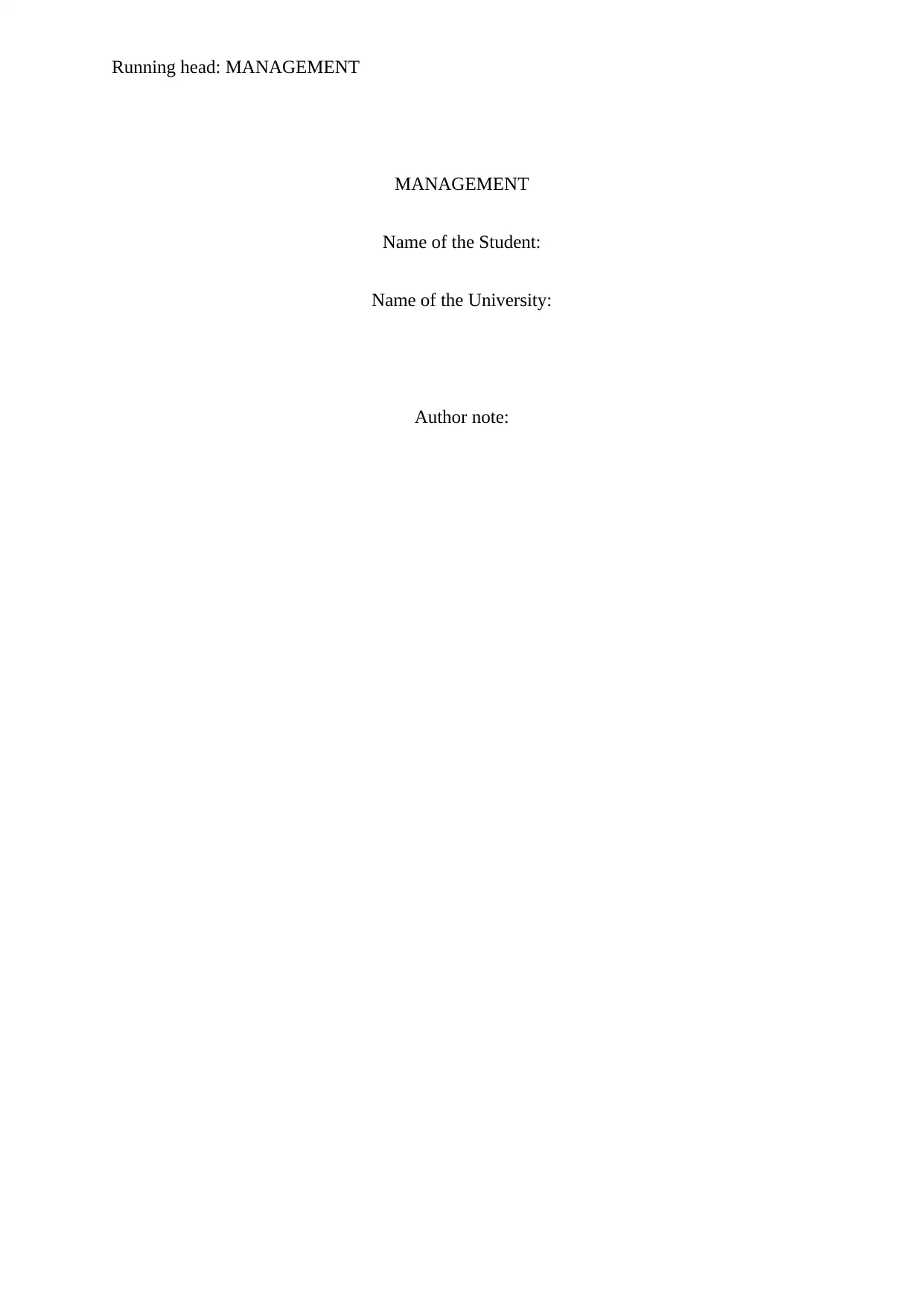
Running head: MANAGEMENT
MANAGEMENT
Name of the Student:
Name of the University:
Author note:
MANAGEMENT
Name of the Student:
Name of the University:
Author note:
Paraphrase This Document
Need a fresh take? Get an instant paraphrase of this document with our AI Paraphraser
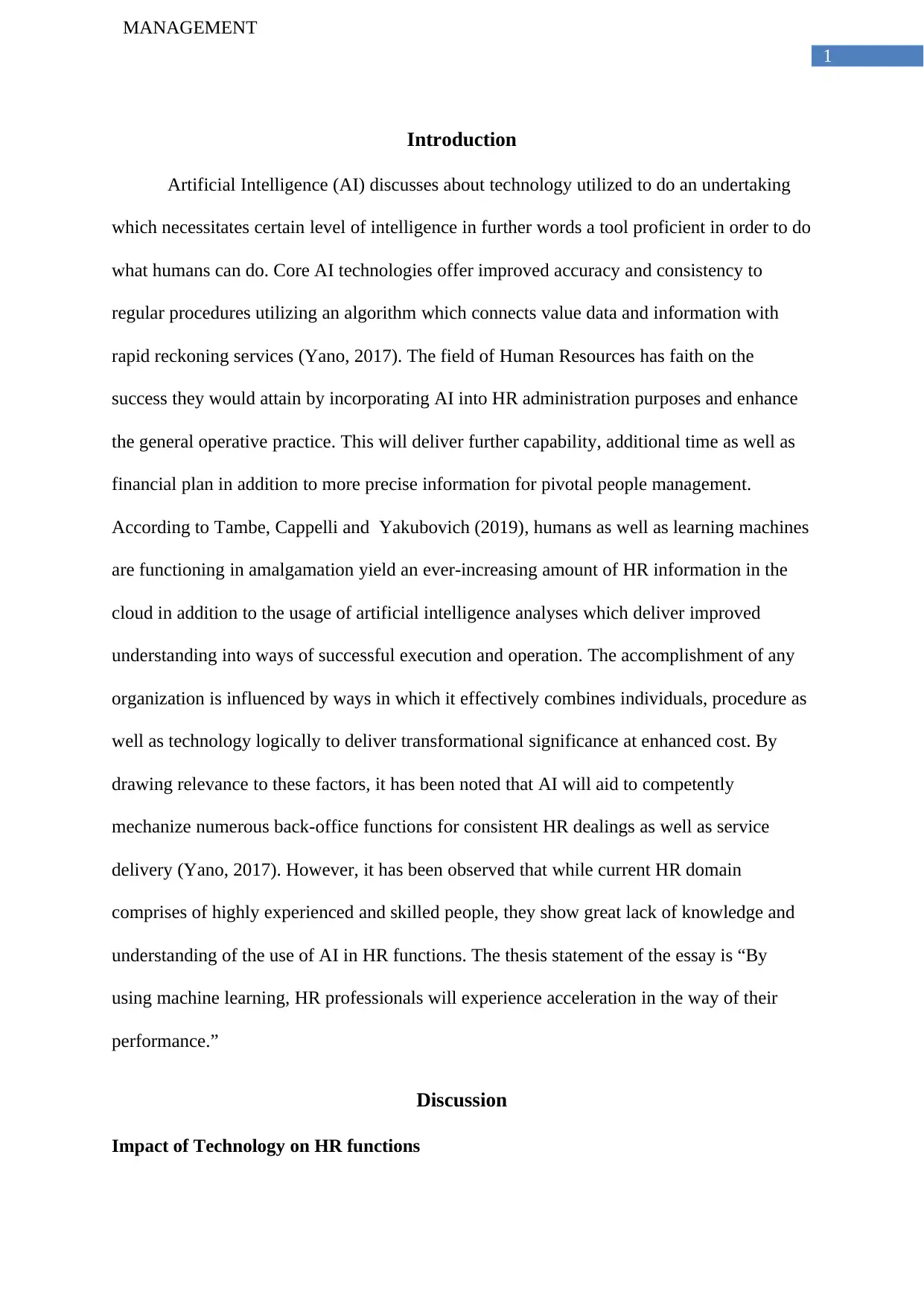
1
MANAGEMENT
Introduction
Artificial Intelligence (AI) discusses about technology utilized to do an undertaking
which necessitates certain level of intelligence in further words a tool proficient in order to do
what humans can do. Core AI technologies offer improved accuracy and consistency to
regular procedures utilizing an algorithm which connects value data and information with
rapid reckoning services (Yano, 2017). The field of Human Resources has faith on the
success they would attain by incorporating AI into HR administration purposes and enhance
the general operative practice. This will deliver further capability, additional time as well as
financial plan in addition to more precise information for pivotal people management.
According to Tambe, Cappelli and Yakubovich (2019), humans as well as learning machines
are functioning in amalgamation yield an ever-increasing amount of HR information in the
cloud in addition to the usage of artificial intelligence analyses which deliver improved
understanding into ways of successful execution and operation. The accomplishment of any
organization is influenced by ways in which it effectively combines individuals, procedure as
well as technology logically to deliver transformational significance at enhanced cost. By
drawing relevance to these factors, it has been noted that AI will aid to competently
mechanize numerous back-office functions for consistent HR dealings as well as service
delivery (Yano, 2017). However, it has been observed that while current HR domain
comprises of highly experienced and skilled people, they show great lack of knowledge and
understanding of the use of AI in HR functions. The thesis statement of the essay is “By
using machine learning, HR professionals will experience acceleration in the way of their
performance.”
Discussion
Impact of Technology on HR functions
MANAGEMENT
Introduction
Artificial Intelligence (AI) discusses about technology utilized to do an undertaking
which necessitates certain level of intelligence in further words a tool proficient in order to do
what humans can do. Core AI technologies offer improved accuracy and consistency to
regular procedures utilizing an algorithm which connects value data and information with
rapid reckoning services (Yano, 2017). The field of Human Resources has faith on the
success they would attain by incorporating AI into HR administration purposes and enhance
the general operative practice. This will deliver further capability, additional time as well as
financial plan in addition to more precise information for pivotal people management.
According to Tambe, Cappelli and Yakubovich (2019), humans as well as learning machines
are functioning in amalgamation yield an ever-increasing amount of HR information in the
cloud in addition to the usage of artificial intelligence analyses which deliver improved
understanding into ways of successful execution and operation. The accomplishment of any
organization is influenced by ways in which it effectively combines individuals, procedure as
well as technology logically to deliver transformational significance at enhanced cost. By
drawing relevance to these factors, it has been noted that AI will aid to competently
mechanize numerous back-office functions for consistent HR dealings as well as service
delivery (Yano, 2017). However, it has been observed that while current HR domain
comprises of highly experienced and skilled people, they show great lack of knowledge and
understanding of the use of AI in HR functions. The thesis statement of the essay is “By
using machine learning, HR professionals will experience acceleration in the way of their
performance.”
Discussion
Impact of Technology on HR functions
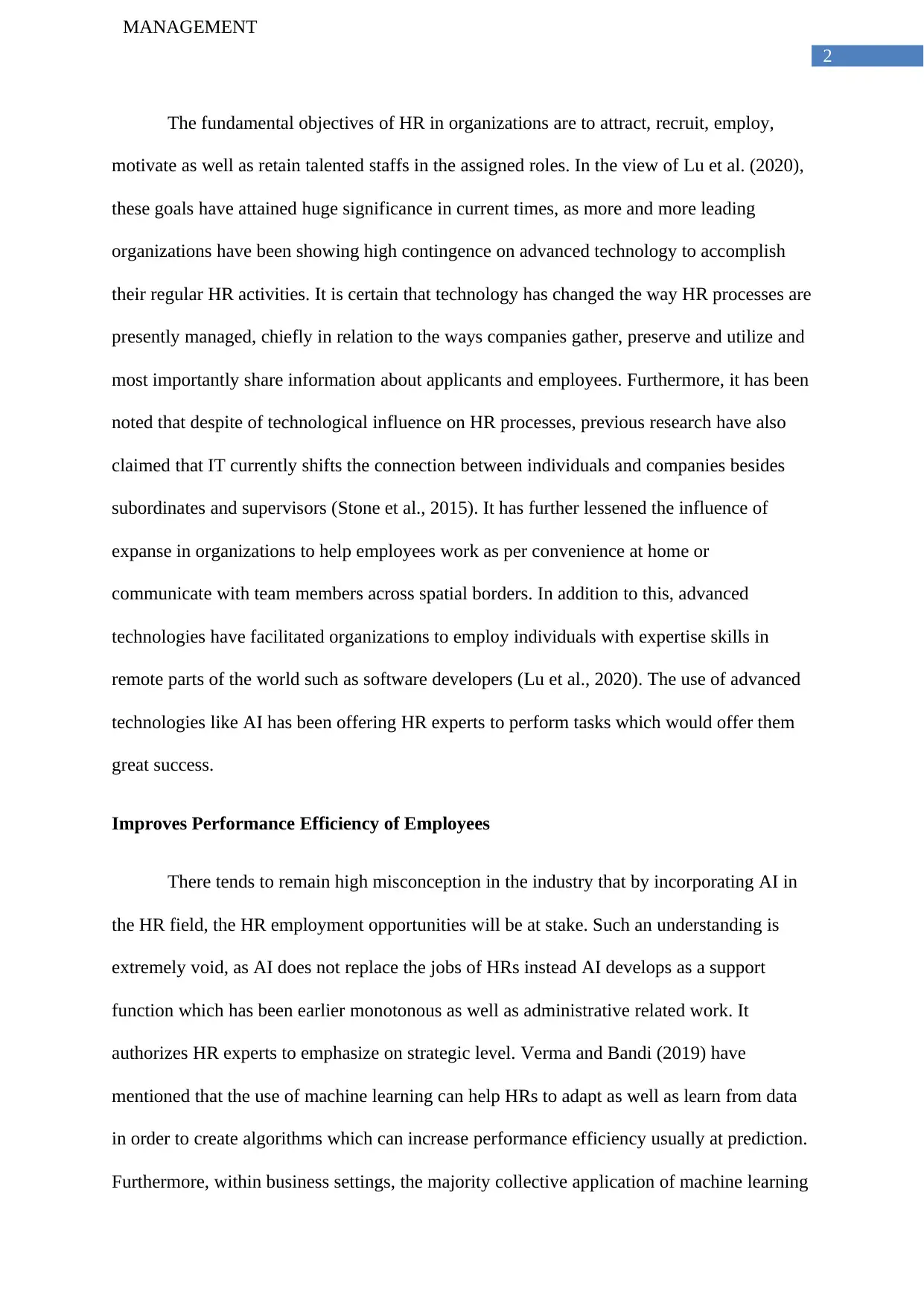
2
MANAGEMENT
The fundamental objectives of HR in organizations are to attract, recruit, employ,
motivate as well as retain talented staffs in the assigned roles. In the view of Lu et al. (2020),
these goals have attained huge significance in current times, as more and more leading
organizations have been showing high contingence on advanced technology to accomplish
their regular HR activities. It is certain that technology has changed the way HR processes are
presently managed, chiefly in relation to the ways companies gather, preserve and utilize and
most importantly share information about applicants and employees. Furthermore, it has been
noted that despite of technological influence on HR processes, previous research have also
claimed that IT currently shifts the connection between individuals and companies besides
subordinates and supervisors (Stone et al., 2015). It has further lessened the influence of
expanse in organizations to help employees work as per convenience at home or
communicate with team members across spatial borders. In addition to this, advanced
technologies have facilitated organizations to employ individuals with expertise skills in
remote parts of the world such as software developers (Lu et al., 2020). The use of advanced
technologies like AI has been offering HR experts to perform tasks which would offer them
great success.
Improves Performance Efficiency of Employees
There tends to remain high misconception in the industry that by incorporating AI in
the HR field, the HR employment opportunities will be at stake. Such an understanding is
extremely void, as AI does not replace the jobs of HRs instead AI develops as a support
function which has been earlier monotonous as well as administrative related work. It
authorizes HR experts to emphasize on strategic level. Verma and Bandi (2019) have
mentioned that the use of machine learning can help HRs to adapt as well as learn from data
in order to create algorithms which can increase performance efficiency usually at prediction.
Furthermore, within business settings, the majority collective application of machine learning
MANAGEMENT
The fundamental objectives of HR in organizations are to attract, recruit, employ,
motivate as well as retain talented staffs in the assigned roles. In the view of Lu et al. (2020),
these goals have attained huge significance in current times, as more and more leading
organizations have been showing high contingence on advanced technology to accomplish
their regular HR activities. It is certain that technology has changed the way HR processes are
presently managed, chiefly in relation to the ways companies gather, preserve and utilize and
most importantly share information about applicants and employees. Furthermore, it has been
noted that despite of technological influence on HR processes, previous research have also
claimed that IT currently shifts the connection between individuals and companies besides
subordinates and supervisors (Stone et al., 2015). It has further lessened the influence of
expanse in organizations to help employees work as per convenience at home or
communicate with team members across spatial borders. In addition to this, advanced
technologies have facilitated organizations to employ individuals with expertise skills in
remote parts of the world such as software developers (Lu et al., 2020). The use of advanced
technologies like AI has been offering HR experts to perform tasks which would offer them
great success.
Improves Performance Efficiency of Employees
There tends to remain high misconception in the industry that by incorporating AI in
the HR field, the HR employment opportunities will be at stake. Such an understanding is
extremely void, as AI does not replace the jobs of HRs instead AI develops as a support
function which has been earlier monotonous as well as administrative related work. It
authorizes HR experts to emphasize on strategic level. Verma and Bandi (2019) have
mentioned that the use of machine learning can help HRs to adapt as well as learn from data
in order to create algorithms which can increase performance efficiency usually at prediction.
Furthermore, within business settings, the majority collective application of machine learning
⊘ This is a preview!⊘
Do you want full access?
Subscribe today to unlock all pages.

Trusted by 1+ million students worldwide
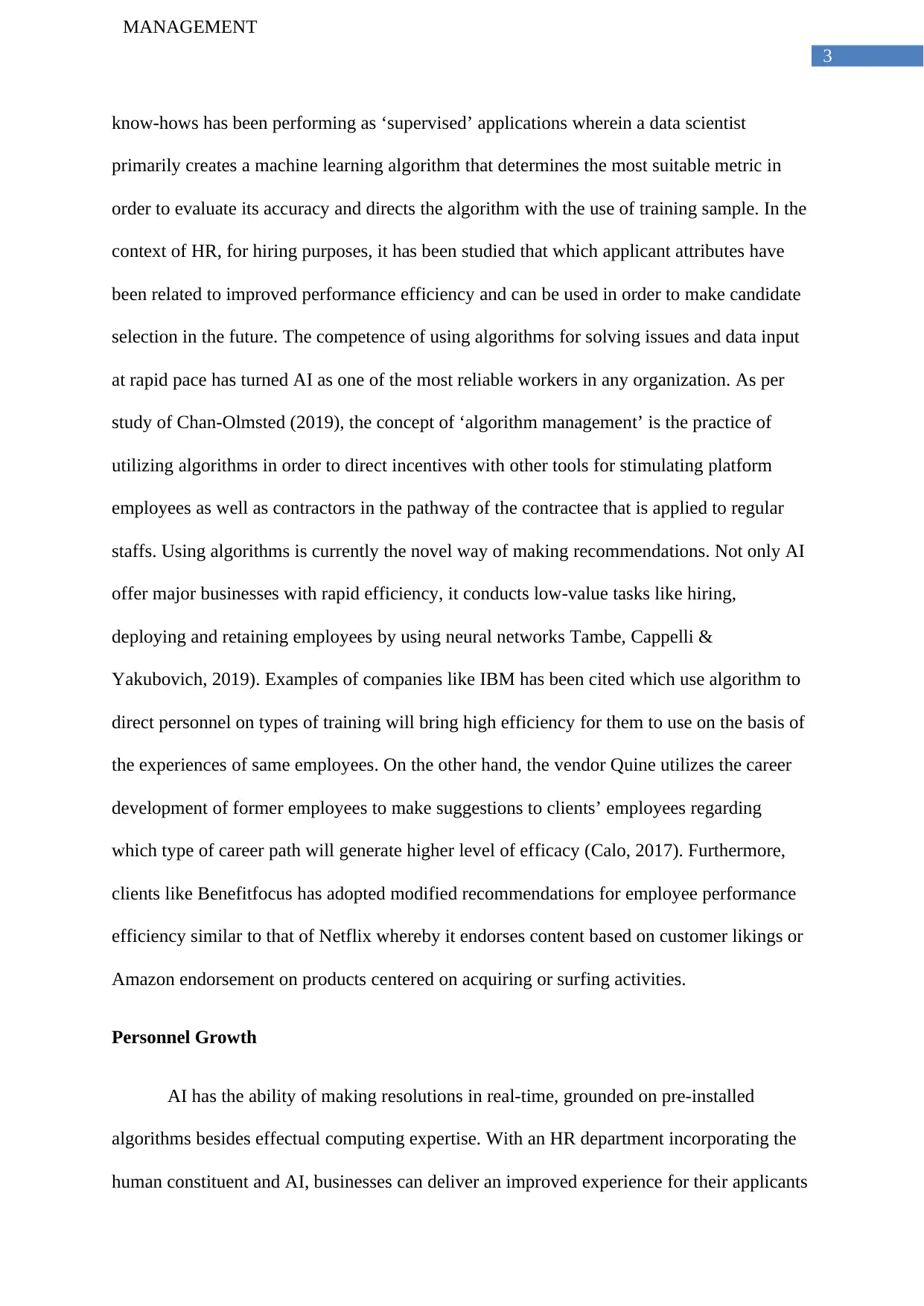
3
MANAGEMENT
know-hows has been performing as ‘supervised’ applications wherein a data scientist
primarily creates a machine learning algorithm that determines the most suitable metric in
order to evaluate its accuracy and directs the algorithm with the use of training sample. In the
context of HR, for hiring purposes, it has been studied that which applicant attributes have
been related to improved performance efficiency and can be used in order to make candidate
selection in the future. The competence of using algorithms for solving issues and data input
at rapid pace has turned AI as one of the most reliable workers in any organization. As per
study of Chan-Olmsted (2019), the concept of ‘algorithm management’ is the practice of
utilizing algorithms in order to direct incentives with other tools for stimulating platform
employees as well as contractors in the pathway of the contractee that is applied to regular
staffs. Using algorithms is currently the novel way of making recommendations. Not only AI
offer major businesses with rapid efficiency, it conducts low-value tasks like hiring,
deploying and retaining employees by using neural networks Tambe, Cappelli &
Yakubovich, 2019). Examples of companies like IBM has been cited which use algorithm to
direct personnel on types of training will bring high efficiency for them to use on the basis of
the experiences of same employees. On the other hand, the vendor Quine utilizes the career
development of former employees to make suggestions to clients’ employees regarding
which type of career path will generate higher level of efficacy (Calo, 2017). Furthermore,
clients like Benefitfocus has adopted modified recommendations for employee performance
efficiency similar to that of Netflix whereby it endorses content based on customer likings or
Amazon endorsement on products centered on acquiring or surfing activities.
Personnel Growth
AI has the ability of making resolutions in real-time, grounded on pre-installed
algorithms besides effectual computing expertise. With an HR department incorporating the
human constituent and AI, businesses can deliver an improved experience for their applicants
MANAGEMENT
know-hows has been performing as ‘supervised’ applications wherein a data scientist
primarily creates a machine learning algorithm that determines the most suitable metric in
order to evaluate its accuracy and directs the algorithm with the use of training sample. In the
context of HR, for hiring purposes, it has been studied that which applicant attributes have
been related to improved performance efficiency and can be used in order to make candidate
selection in the future. The competence of using algorithms for solving issues and data input
at rapid pace has turned AI as one of the most reliable workers in any organization. As per
study of Chan-Olmsted (2019), the concept of ‘algorithm management’ is the practice of
utilizing algorithms in order to direct incentives with other tools for stimulating platform
employees as well as contractors in the pathway of the contractee that is applied to regular
staffs. Using algorithms is currently the novel way of making recommendations. Not only AI
offer major businesses with rapid efficiency, it conducts low-value tasks like hiring,
deploying and retaining employees by using neural networks Tambe, Cappelli &
Yakubovich, 2019). Examples of companies like IBM has been cited which use algorithm to
direct personnel on types of training will bring high efficiency for them to use on the basis of
the experiences of same employees. On the other hand, the vendor Quine utilizes the career
development of former employees to make suggestions to clients’ employees regarding
which type of career path will generate higher level of efficacy (Calo, 2017). Furthermore,
clients like Benefitfocus has adopted modified recommendations for employee performance
efficiency similar to that of Netflix whereby it endorses content based on customer likings or
Amazon endorsement on products centered on acquiring or surfing activities.
Personnel Growth
AI has the ability of making resolutions in real-time, grounded on pre-installed
algorithms besides effectual computing expertise. With an HR department incorporating the
human constituent and AI, businesses can deliver an improved experience for their applicants
Paraphrase This Document
Need a fresh take? Get an instant paraphrase of this document with our AI Paraphraser
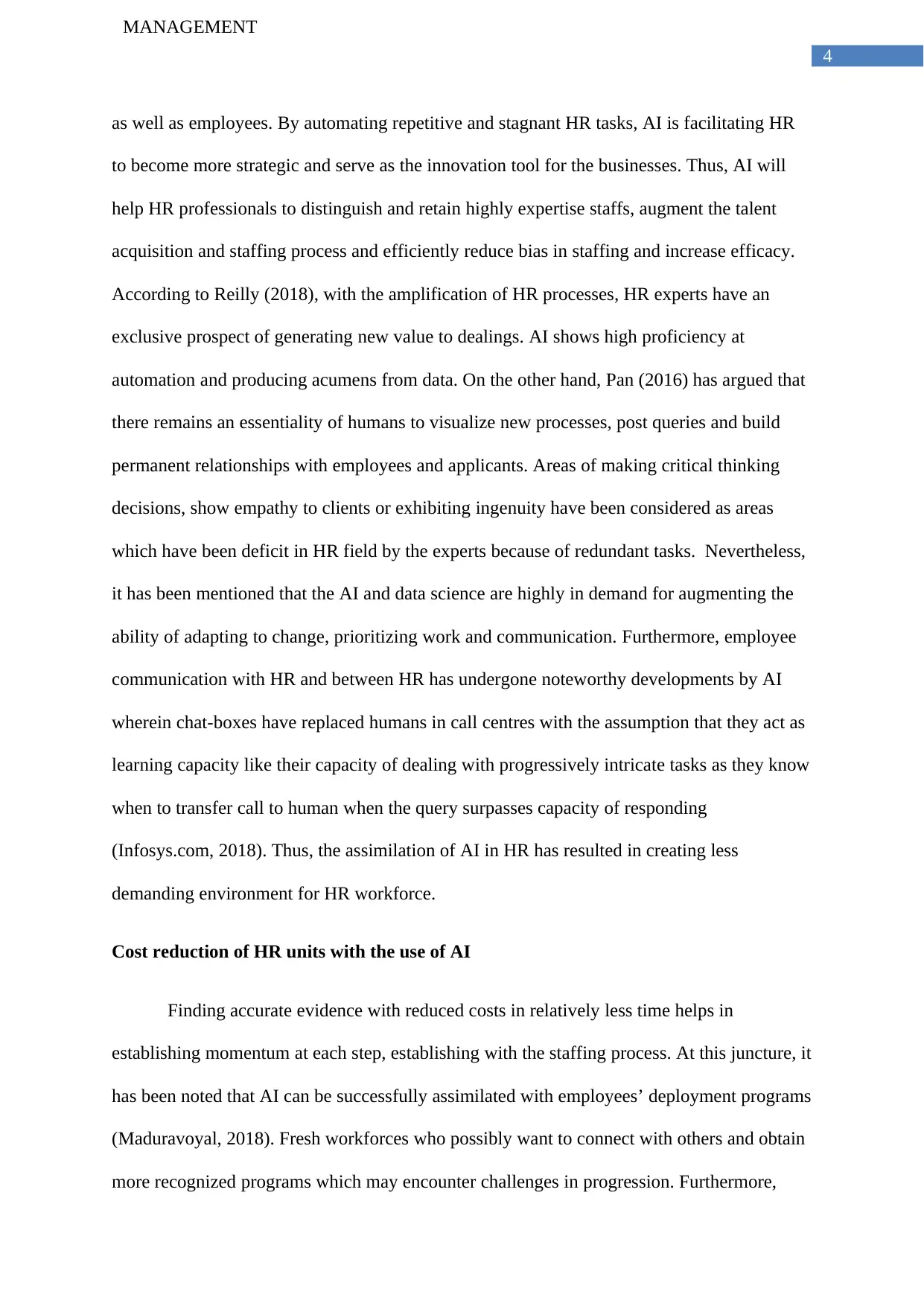
4
MANAGEMENT
as well as employees. By automating repetitive and stagnant HR tasks, AI is facilitating HR
to become more strategic and serve as the innovation tool for the businesses. Thus, AI will
help HR professionals to distinguish and retain highly expertise staffs, augment the talent
acquisition and staffing process and efficiently reduce bias in staffing and increase efficacy.
According to Reilly (2018), with the amplification of HR processes, HR experts have an
exclusive prospect of generating new value to dealings. AI shows high proficiency at
automation and producing acumens from data. On the other hand, Pan (2016) has argued that
there remains an essentiality of humans to visualize new processes, post queries and build
permanent relationships with employees and applicants. Areas of making critical thinking
decisions, show empathy to clients or exhibiting ingenuity have been considered as areas
which have been deficit in HR field by the experts because of redundant tasks. Nevertheless,
it has been mentioned that the AI and data science are highly in demand for augmenting the
ability of adapting to change, prioritizing work and communication. Furthermore, employee
communication with HR and between HR has undergone noteworthy developments by AI
wherein chat-boxes have replaced humans in call centres with the assumption that they act as
learning capacity like their capacity of dealing with progressively intricate tasks as they know
when to transfer call to human when the query surpasses capacity of responding
(Infosys.com, 2018). Thus, the assimilation of AI in HR has resulted in creating less
demanding environment for HR workforce.
Cost reduction of HR units with the use of AI
Finding accurate evidence with reduced costs in relatively less time helps in
establishing momentum at each step, establishing with the staffing process. At this juncture, it
has been noted that AI can be successfully assimilated with employees’ deployment programs
(Maduravoyal, 2018). Fresh workforces who possibly want to connect with others and obtain
more recognized programs which may encounter challenges in progression. Furthermore,
MANAGEMENT
as well as employees. By automating repetitive and stagnant HR tasks, AI is facilitating HR
to become more strategic and serve as the innovation tool for the businesses. Thus, AI will
help HR professionals to distinguish and retain highly expertise staffs, augment the talent
acquisition and staffing process and efficiently reduce bias in staffing and increase efficacy.
According to Reilly (2018), with the amplification of HR processes, HR experts have an
exclusive prospect of generating new value to dealings. AI shows high proficiency at
automation and producing acumens from data. On the other hand, Pan (2016) has argued that
there remains an essentiality of humans to visualize new processes, post queries and build
permanent relationships with employees and applicants. Areas of making critical thinking
decisions, show empathy to clients or exhibiting ingenuity have been considered as areas
which have been deficit in HR field by the experts because of redundant tasks. Nevertheless,
it has been mentioned that the AI and data science are highly in demand for augmenting the
ability of adapting to change, prioritizing work and communication. Furthermore, employee
communication with HR and between HR has undergone noteworthy developments by AI
wherein chat-boxes have replaced humans in call centres with the assumption that they act as
learning capacity like their capacity of dealing with progressively intricate tasks as they know
when to transfer call to human when the query surpasses capacity of responding
(Infosys.com, 2018). Thus, the assimilation of AI in HR has resulted in creating less
demanding environment for HR workforce.
Cost reduction of HR units with the use of AI
Finding accurate evidence with reduced costs in relatively less time helps in
establishing momentum at each step, establishing with the staffing process. At this juncture, it
has been noted that AI can be successfully assimilated with employees’ deployment programs
(Maduravoyal, 2018). Fresh workforces who possibly want to connect with others and obtain
more recognized programs which may encounter challenges in progression. Furthermore,
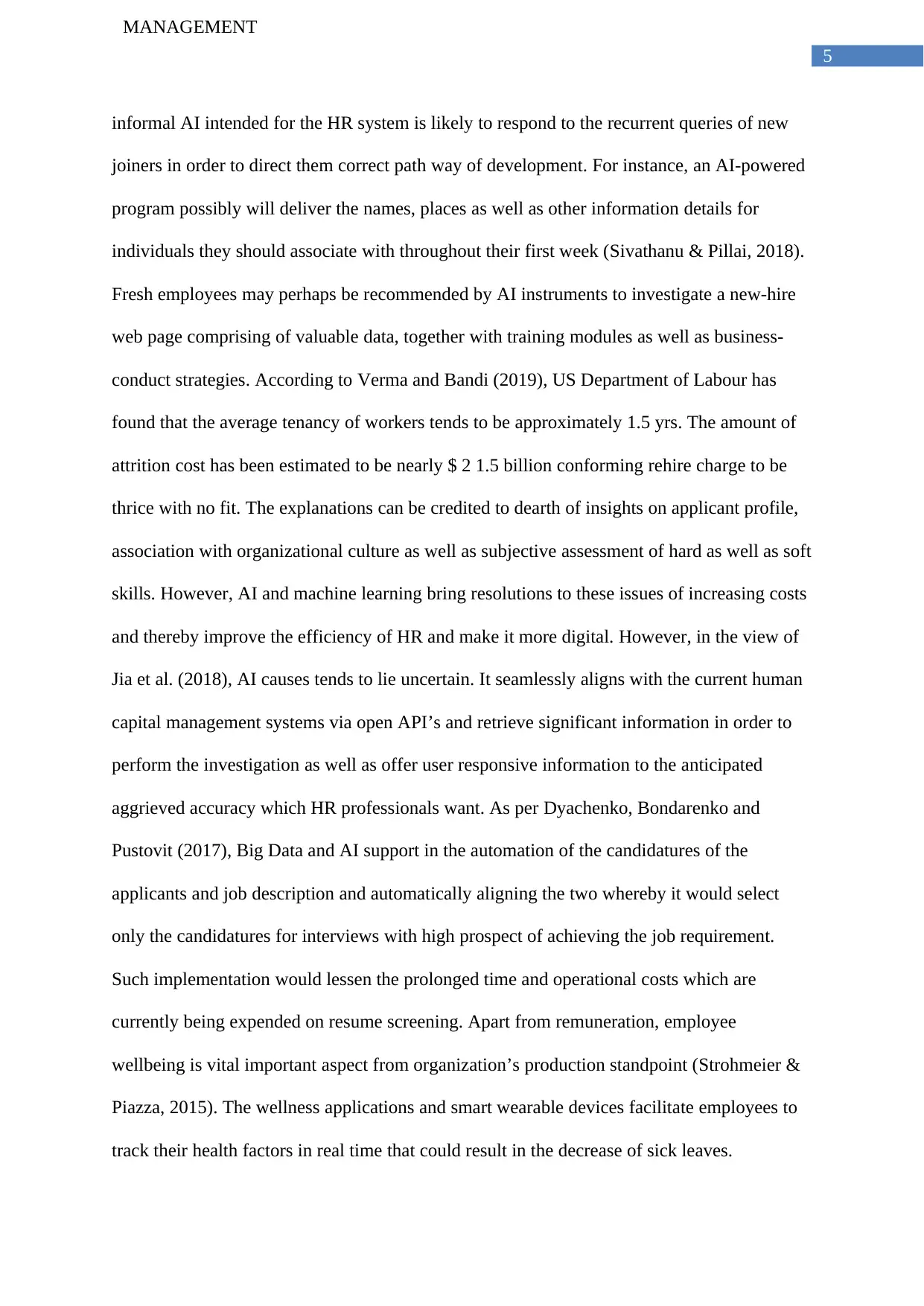
5
MANAGEMENT
informal AI intended for the HR system is likely to respond to the recurrent queries of new
joiners in order to direct them correct path way of development. For instance, an AI-powered
program possibly will deliver the names, places as well as other information details for
individuals they should associate with throughout their first week (Sivathanu & Pillai, 2018).
Fresh employees may perhaps be recommended by AI instruments to investigate a new-hire
web page comprising of valuable data, together with training modules as well as business-
conduct strategies. According to Verma and Bandi (2019), US Department of Labour has
found that the average tenancy of workers tends to be approximately 1.5 yrs. The amount of
attrition cost has been estimated to be nearly $ 2 1.5 billion conforming rehire charge to be
thrice with no fit. The explanations can be credited to dearth of insights on applicant profile,
association with organizational culture as well as subjective assessment of hard as well as soft
skills. However, AI and machine learning bring resolutions to these issues of increasing costs
and thereby improve the efficiency of HR and make it more digital. However, in the view of
Jia et al. (2018), AI causes tends to lie uncertain. It seamlessly aligns with the current human
capital management systems via open API’s and retrieve significant information in order to
perform the investigation as well as offer user responsive information to the anticipated
aggrieved accuracy which HR professionals want. As per Dyachenko, Bondarenko and
Pustovit (2017), Big Data and AI support in the automation of the candidatures of the
applicants and job description and automatically aligning the two whereby it would select
only the candidatures for interviews with high prospect of achieving the job requirement.
Such implementation would lessen the prolonged time and operational costs which are
currently being expended on resume screening. Apart from remuneration, employee
wellbeing is vital important aspect from organization’s production standpoint (Strohmeier &
Piazza, 2015). The wellness applications and smart wearable devices facilitate employees to
track their health factors in real time that could result in the decrease of sick leaves.
MANAGEMENT
informal AI intended for the HR system is likely to respond to the recurrent queries of new
joiners in order to direct them correct path way of development. For instance, an AI-powered
program possibly will deliver the names, places as well as other information details for
individuals they should associate with throughout their first week (Sivathanu & Pillai, 2018).
Fresh employees may perhaps be recommended by AI instruments to investigate a new-hire
web page comprising of valuable data, together with training modules as well as business-
conduct strategies. According to Verma and Bandi (2019), US Department of Labour has
found that the average tenancy of workers tends to be approximately 1.5 yrs. The amount of
attrition cost has been estimated to be nearly $ 2 1.5 billion conforming rehire charge to be
thrice with no fit. The explanations can be credited to dearth of insights on applicant profile,
association with organizational culture as well as subjective assessment of hard as well as soft
skills. However, AI and machine learning bring resolutions to these issues of increasing costs
and thereby improve the efficiency of HR and make it more digital. However, in the view of
Jia et al. (2018), AI causes tends to lie uncertain. It seamlessly aligns with the current human
capital management systems via open API’s and retrieve significant information in order to
perform the investigation as well as offer user responsive information to the anticipated
aggrieved accuracy which HR professionals want. As per Dyachenko, Bondarenko and
Pustovit (2017), Big Data and AI support in the automation of the candidatures of the
applicants and job description and automatically aligning the two whereby it would select
only the candidatures for interviews with high prospect of achieving the job requirement.
Such implementation would lessen the prolonged time and operational costs which are
currently being expended on resume screening. Apart from remuneration, employee
wellbeing is vital important aspect from organization’s production standpoint (Strohmeier &
Piazza, 2015). The wellness applications and smart wearable devices facilitate employees to
track their health factors in real time that could result in the decrease of sick leaves.
⊘ This is a preview!⊘
Do you want full access?
Subscribe today to unlock all pages.

Trusted by 1+ million students worldwide
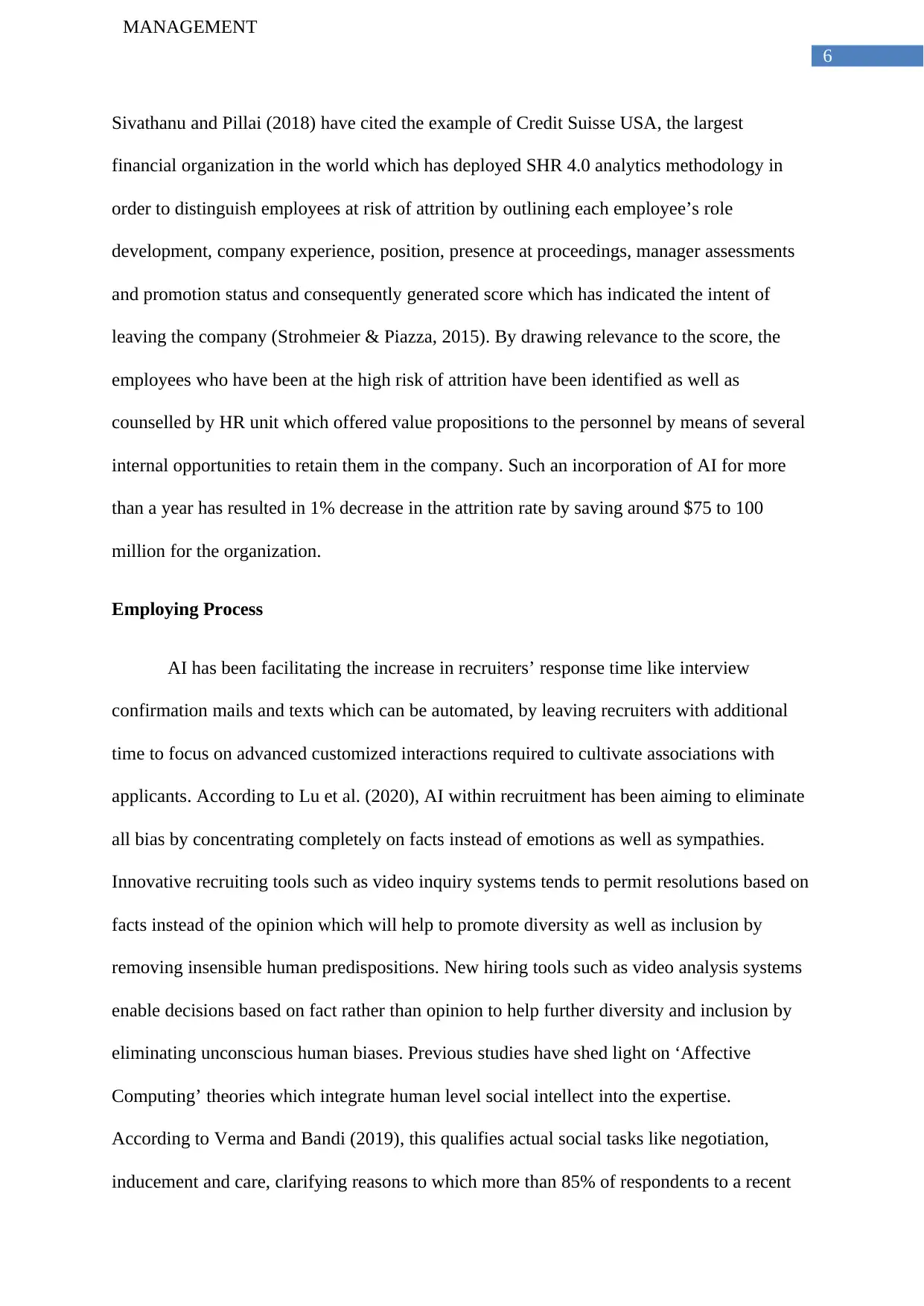
6
MANAGEMENT
Sivathanu and Pillai (2018) have cited the example of Credit Suisse USA, the largest
financial organization in the world which has deployed SHR 4.0 analytics methodology in
order to distinguish employees at risk of attrition by outlining each employee’s role
development, company experience, position, presence at proceedings, manager assessments
and promotion status and consequently generated score which has indicated the intent of
leaving the company (Strohmeier & Piazza, 2015). By drawing relevance to the score, the
employees who have been at the high risk of attrition have been identified as well as
counselled by HR unit which offered value propositions to the personnel by means of several
internal opportunities to retain them in the company. Such an incorporation of AI for more
than a year has resulted in 1% decrease in the attrition rate by saving around $75 to 100
million for the organization.
Employing Process
AI has been facilitating the increase in recruiters’ response time like interview
confirmation mails and texts which can be automated, by leaving recruiters with additional
time to focus on advanced customized interactions required to cultivate associations with
applicants. According to Lu et al. (2020), AI within recruitment has been aiming to eliminate
all bias by concentrating completely on facts instead of emotions as well as sympathies.
Innovative recruiting tools such as video inquiry systems tends to permit resolutions based on
facts instead of the opinion which will help to promote diversity as well as inclusion by
removing insensible human predispositions. New hiring tools such as video analysis systems
enable decisions based on fact rather than opinion to help further diversity and inclusion by
eliminating unconscious human biases. Previous studies have shed light on ‘Affective
Computing’ theories which integrate human level social intellect into the expertise.
According to Verma and Bandi (2019), this qualifies actual social tasks like negotiation,
inducement and care, clarifying reasons to which more than 85% of respondents to a recent
MANAGEMENT
Sivathanu and Pillai (2018) have cited the example of Credit Suisse USA, the largest
financial organization in the world which has deployed SHR 4.0 analytics methodology in
order to distinguish employees at risk of attrition by outlining each employee’s role
development, company experience, position, presence at proceedings, manager assessments
and promotion status and consequently generated score which has indicated the intent of
leaving the company (Strohmeier & Piazza, 2015). By drawing relevance to the score, the
employees who have been at the high risk of attrition have been identified as well as
counselled by HR unit which offered value propositions to the personnel by means of several
internal opportunities to retain them in the company. Such an incorporation of AI for more
than a year has resulted in 1% decrease in the attrition rate by saving around $75 to 100
million for the organization.
Employing Process
AI has been facilitating the increase in recruiters’ response time like interview
confirmation mails and texts which can be automated, by leaving recruiters with additional
time to focus on advanced customized interactions required to cultivate associations with
applicants. According to Lu et al. (2020), AI within recruitment has been aiming to eliminate
all bias by concentrating completely on facts instead of emotions as well as sympathies.
Innovative recruiting tools such as video inquiry systems tends to permit resolutions based on
facts instead of the opinion which will help to promote diversity as well as inclusion by
removing insensible human predispositions. New hiring tools such as video analysis systems
enable decisions based on fact rather than opinion to help further diversity and inclusion by
eliminating unconscious human biases. Previous studies have shed light on ‘Affective
Computing’ theories which integrate human level social intellect into the expertise.
According to Verma and Bandi (2019), this qualifies actual social tasks like negotiation,
inducement and care, clarifying reasons to which more than 85% of respondents to a recent
Paraphrase This Document
Need a fresh take? Get an instant paraphrase of this document with our AI Paraphraser
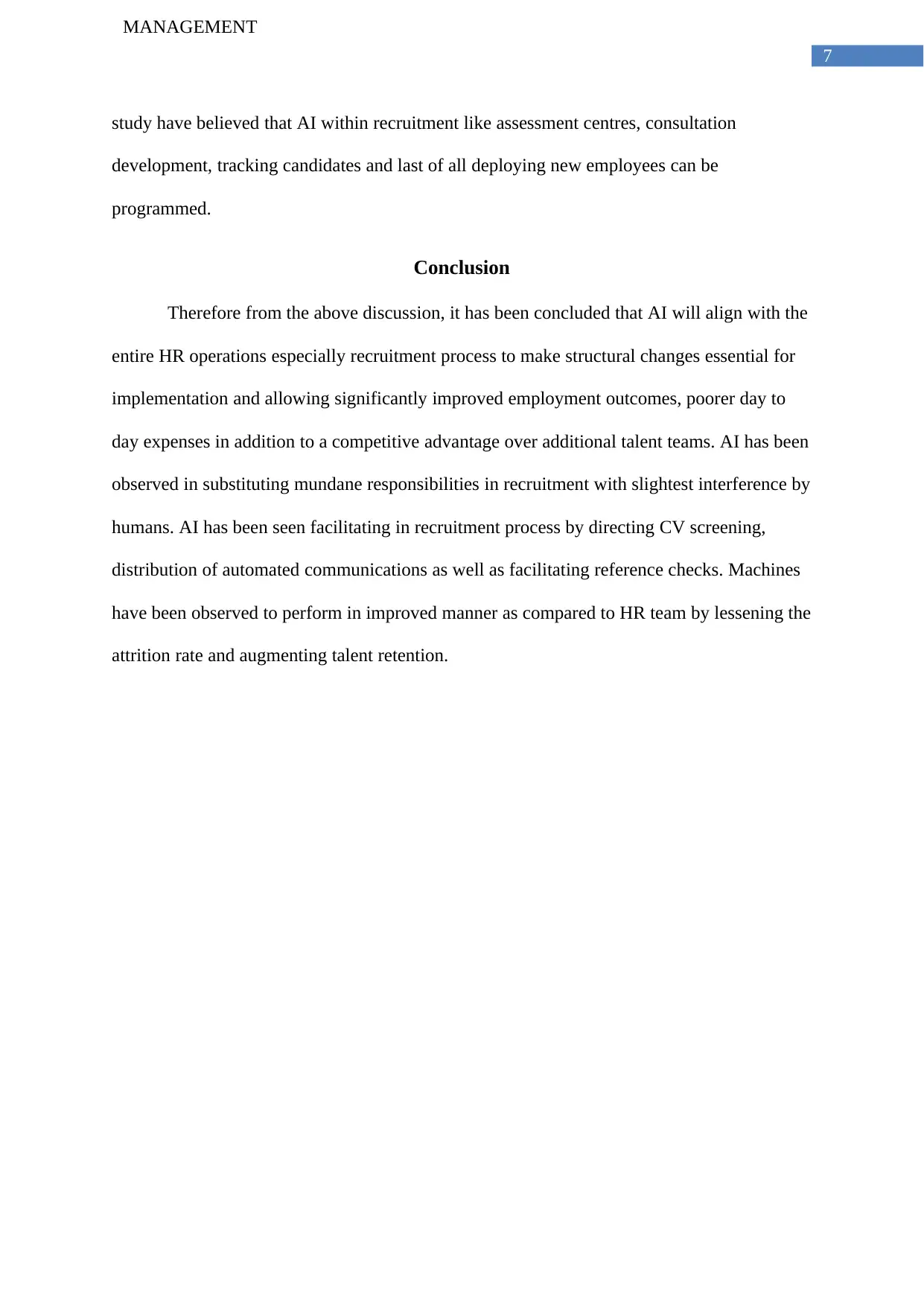
7
MANAGEMENT
study have believed that AI within recruitment like assessment centres, consultation
development, tracking candidates and last of all deploying new employees can be
programmed.
Conclusion
Therefore from the above discussion, it has been concluded that AI will align with the
entire HR operations especially recruitment process to make structural changes essential for
implementation and allowing significantly improved employment outcomes, poorer day to
day expenses in addition to a competitive advantage over additional talent teams. AI has been
observed in substituting mundane responsibilities in recruitment with slightest interference by
humans. AI has been seen facilitating in recruitment process by directing CV screening,
distribution of automated communications as well as facilitating reference checks. Machines
have been observed to perform in improved manner as compared to HR team by lessening the
attrition rate and augmenting talent retention.
MANAGEMENT
study have believed that AI within recruitment like assessment centres, consultation
development, tracking candidates and last of all deploying new employees can be
programmed.
Conclusion
Therefore from the above discussion, it has been concluded that AI will align with the
entire HR operations especially recruitment process to make structural changes essential for
implementation and allowing significantly improved employment outcomes, poorer day to
day expenses in addition to a competitive advantage over additional talent teams. AI has been
observed in substituting mundane responsibilities in recruitment with slightest interference by
humans. AI has been seen facilitating in recruitment process by directing CV screening,
distribution of automated communications as well as facilitating reference checks. Machines
have been observed to perform in improved manner as compared to HR team by lessening the
attrition rate and augmenting talent retention.
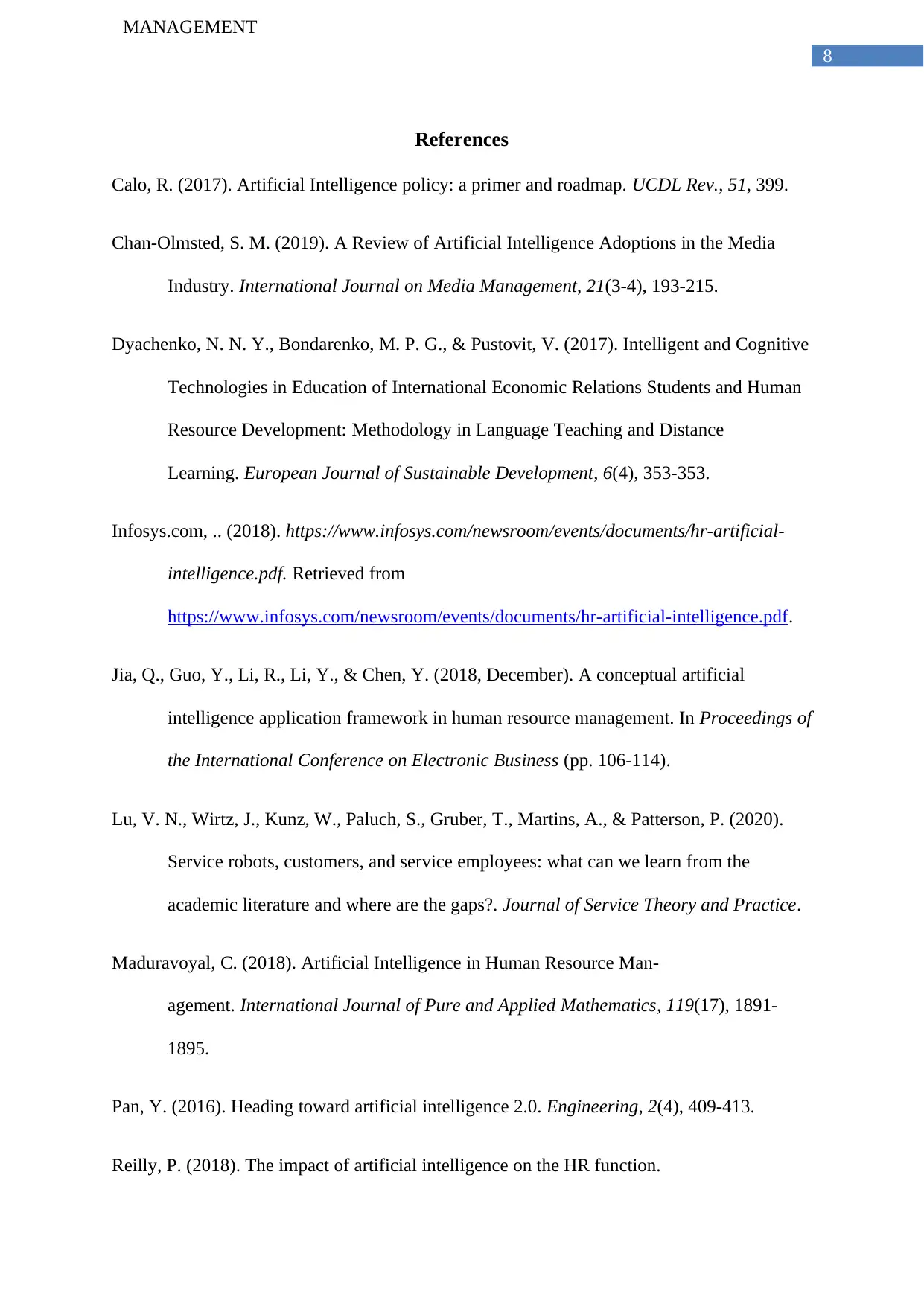
8
MANAGEMENT
References
Calo, R. (2017). Artificial Intelligence policy: a primer and roadmap. UCDL Rev., 51, 399.
Chan-Olmsted, S. M. (2019). A Review of Artificial Intelligence Adoptions in the Media
Industry. International Journal on Media Management, 21(3-4), 193-215.
Dyachenko, N. N. Y., Bondarenko, M. P. G., & Pustovit, V. (2017). Intelligent and Cognitive
Technologies in Education of International Economic Relations Students and Human
Resource Development: Methodology in Language Teaching and Distance
Learning. European Journal of Sustainable Development, 6(4), 353-353.
Infosys.com, .. (2018). https://www.infosys.com/newsroom/events/documents/hr-artificial-
intelligence.pdf. Retrieved from
https://www.infosys.com/newsroom/events/documents/hr-artificial-intelligence.pdf.
Jia, Q., Guo, Y., Li, R., Li, Y., & Chen, Y. (2018, December). A conceptual artificial
intelligence application framework in human resource management. In Proceedings of
the International Conference on Electronic Business (pp. 106-114).
Lu, V. N., Wirtz, J., Kunz, W., Paluch, S., Gruber, T., Martins, A., & Patterson, P. (2020).
Service robots, customers, and service employees: what can we learn from the
academic literature and where are the gaps?. Journal of Service Theory and Practice.
Maduravoyal, C. (2018). Artificial Intelligence in Human Resource Man-
agement. International Journal of Pure and Applied Mathematics, 119(17), 1891-
1895.
Pan, Y. (2016). Heading toward artificial intelligence 2.0. Engineering, 2(4), 409-413.
Reilly, P. (2018). The impact of artificial intelligence on the HR function.
MANAGEMENT
References
Calo, R. (2017). Artificial Intelligence policy: a primer and roadmap. UCDL Rev., 51, 399.
Chan-Olmsted, S. M. (2019). A Review of Artificial Intelligence Adoptions in the Media
Industry. International Journal on Media Management, 21(3-4), 193-215.
Dyachenko, N. N. Y., Bondarenko, M. P. G., & Pustovit, V. (2017). Intelligent and Cognitive
Technologies in Education of International Economic Relations Students and Human
Resource Development: Methodology in Language Teaching and Distance
Learning. European Journal of Sustainable Development, 6(4), 353-353.
Infosys.com, .. (2018). https://www.infosys.com/newsroom/events/documents/hr-artificial-
intelligence.pdf. Retrieved from
https://www.infosys.com/newsroom/events/documents/hr-artificial-intelligence.pdf.
Jia, Q., Guo, Y., Li, R., Li, Y., & Chen, Y. (2018, December). A conceptual artificial
intelligence application framework in human resource management. In Proceedings of
the International Conference on Electronic Business (pp. 106-114).
Lu, V. N., Wirtz, J., Kunz, W., Paluch, S., Gruber, T., Martins, A., & Patterson, P. (2020).
Service robots, customers, and service employees: what can we learn from the
academic literature and where are the gaps?. Journal of Service Theory and Practice.
Maduravoyal, C. (2018). Artificial Intelligence in Human Resource Man-
agement. International Journal of Pure and Applied Mathematics, 119(17), 1891-
1895.
Pan, Y. (2016). Heading toward artificial intelligence 2.0. Engineering, 2(4), 409-413.
Reilly, P. (2018). The impact of artificial intelligence on the HR function.
⊘ This is a preview!⊘
Do you want full access?
Subscribe today to unlock all pages.

Trusted by 1+ million students worldwide
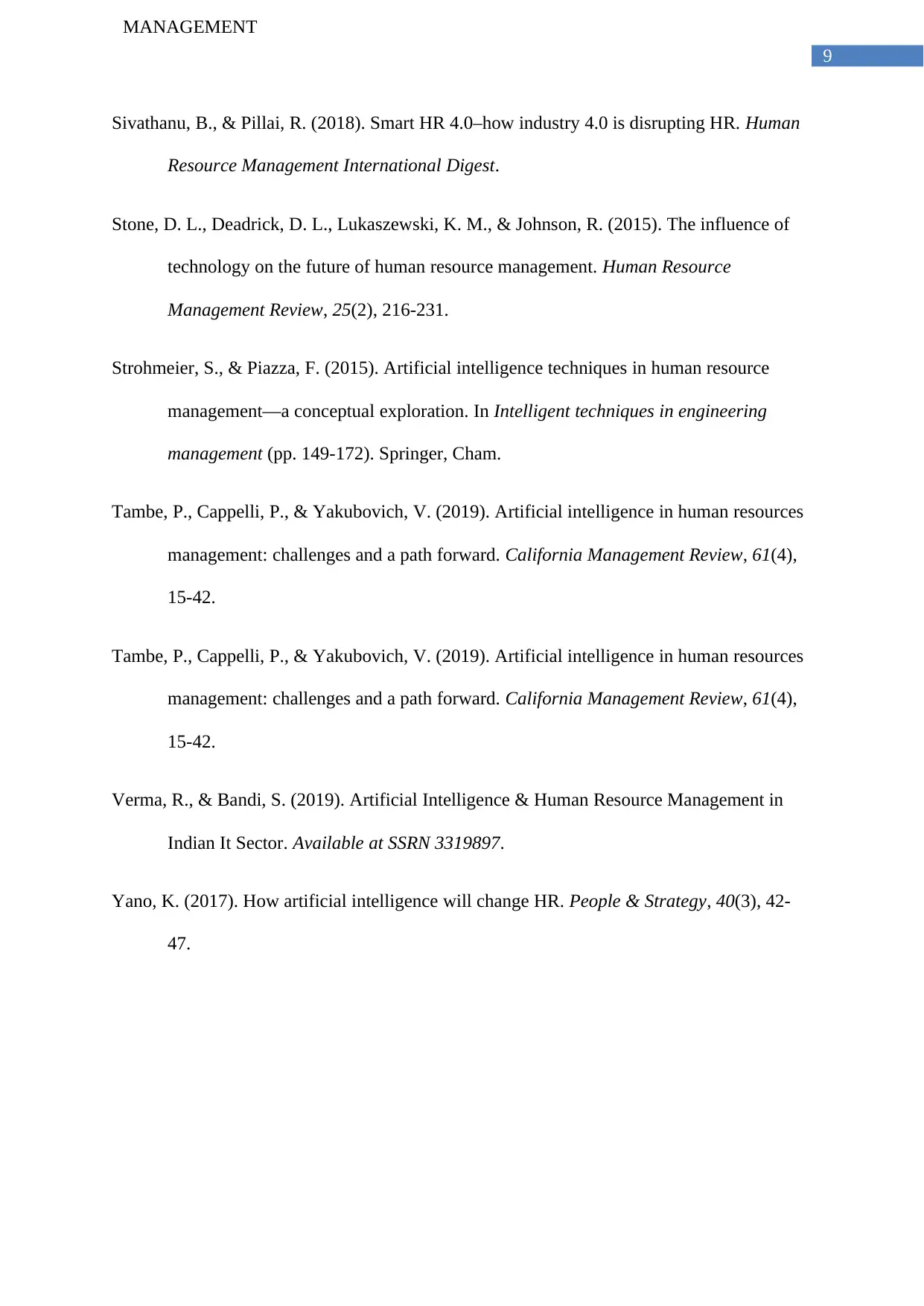
9
MANAGEMENT
Sivathanu, B., & Pillai, R. (2018). Smart HR 4.0–how industry 4.0 is disrupting HR. Human
Resource Management International Digest.
Stone, D. L., Deadrick, D. L., Lukaszewski, K. M., & Johnson, R. (2015). The influence of
technology on the future of human resource management. Human Resource
Management Review, 25(2), 216-231.
Strohmeier, S., & Piazza, F. (2015). Artificial intelligence techniques in human resource
management—a conceptual exploration. In Intelligent techniques in engineering
management (pp. 149-172). Springer, Cham.
Tambe, P., Cappelli, P., & Yakubovich, V. (2019). Artificial intelligence in human resources
management: challenges and a path forward. California Management Review, 61(4),
15-42.
Tambe, P., Cappelli, P., & Yakubovich, V. (2019). Artificial intelligence in human resources
management: challenges and a path forward. California Management Review, 61(4),
15-42.
Verma, R., & Bandi, S. (2019). Artificial Intelligence & Human Resource Management in
Indian It Sector. Available at SSRN 3319897.
Yano, K. (2017). How artificial intelligence will change HR. People & Strategy, 40(3), 42-
47.
MANAGEMENT
Sivathanu, B., & Pillai, R. (2018). Smart HR 4.0–how industry 4.0 is disrupting HR. Human
Resource Management International Digest.
Stone, D. L., Deadrick, D. L., Lukaszewski, K. M., & Johnson, R. (2015). The influence of
technology on the future of human resource management. Human Resource
Management Review, 25(2), 216-231.
Strohmeier, S., & Piazza, F. (2015). Artificial intelligence techniques in human resource
management—a conceptual exploration. In Intelligent techniques in engineering
management (pp. 149-172). Springer, Cham.
Tambe, P., Cappelli, P., & Yakubovich, V. (2019). Artificial intelligence in human resources
management: challenges and a path forward. California Management Review, 61(4),
15-42.
Tambe, P., Cappelli, P., & Yakubovich, V. (2019). Artificial intelligence in human resources
management: challenges and a path forward. California Management Review, 61(4),
15-42.
Verma, R., & Bandi, S. (2019). Artificial Intelligence & Human Resource Management in
Indian It Sector. Available at SSRN 3319897.
Yano, K. (2017). How artificial intelligence will change HR. People & Strategy, 40(3), 42-
47.
1 out of 10
Related Documents
Your All-in-One AI-Powered Toolkit for Academic Success.
+13062052269
info@desklib.com
Available 24*7 on WhatsApp / Email
![[object Object]](/_next/static/media/star-bottom.7253800d.svg)
Unlock your academic potential
Copyright © 2020–2025 A2Z Services. All Rights Reserved. Developed and managed by ZUCOL.





